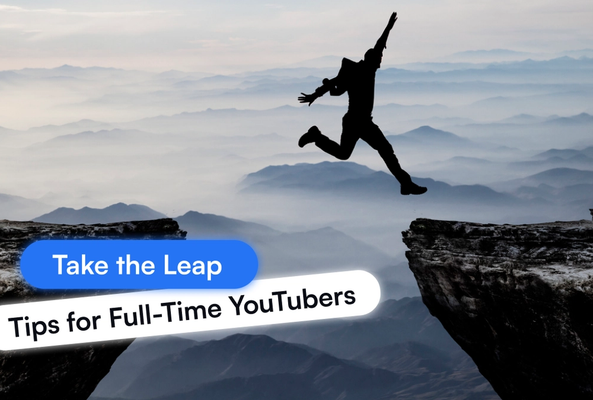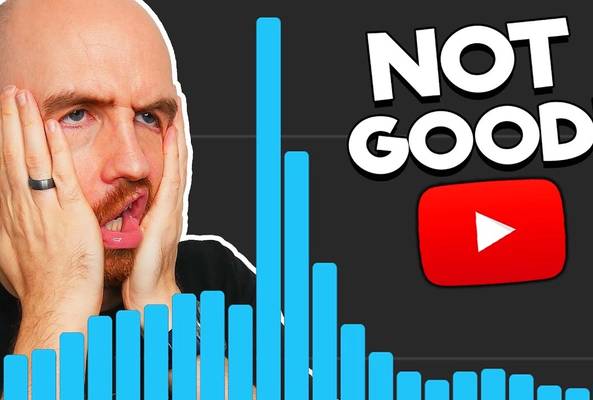Jay Colburn is an experienced writer and editor who spent 15 years in the world of international development. Now he’s exploring new ways to put his word-nerd skills to work on other passions, like fantasy/sci-fi, tabletop RPGs and board games, and the ever-evolving world of digital tech.
Recovering from YouTube Issues: Strikes, Hacks, and Slumps
Imagine waking up to find your YouTube channel frozen, your account hacked, or your views plummeting. Hopefully you'll never deal with this nightmare scenario, but in case you do, we’ll tell you how to resolve it.
The most common YouTube issues tend to fall into three categories:
- Community guideline strikes that freeze your ability to post or stream
- Account hacks that put your content and followers at risk
- Viewership slumps that leave you wondering what went wrong
Facing a Community Guideline Strike
Finding your YouTube channel has been assigned a strike can be a disorienting blow. Fortunately, with some patience and understanding, you can weather the storm.
Understanding YouTube's Strike System
YouTube’s strike system operates on a clear progression. After a preliminary warning, a first strike results in a one-week restriction from certain activities, like posting videos and going live.
A second strike within 90 days results in a two-week restriction. And if you get a third strike in that same 90-day period, your channel may be permanently removed from YouTube.
How to Find Out Why You Received a Strike
Head to YouTube Studio > Channel Violations for details on the strike. There, you’ll see which video was flagged and the reason. Posting copyrighted music without permission is a common violation. In that case, you should research YouTube Copyright Claims vs. Copyright Strikes to learn how YouTube handles copyrighted material.
YouTube content could also be flagged for misinformation, harassment, or other community guideline violations. Knowing exactly what triggered the strike will help you figure out whether to appeal and how to avoid future issues.
How to Appeal a YouTube Strike
You can appeal a strike directly in YouTube Studio, but you should do so only if you believe the strike was issued in error.
Appeals are limited to 1,000 characters, so be concise and focused. When making your appeal, ensure you submit it within 30 days and provide clear, factual information. Explain why you believe your content didn’t violate YouTube’s rules, and include any supporting context. Attaching screenshots or even linking to a screen capture video can add a valuable visual reference to defend your claim.
Once submitted, be prepared to wait, as it might take some time for YouTube to respond. YouTube won’t reverse every strike, but a well-prepared appeal and a respectful tone gives you a fighting chance.
How to Avoid Future Strikes
Prevention is your best strategy for avoiding YouTube issues like strikes. Here are a few tips to stay strike-free:
- Review YouTube’s Community Guidelines before publishing, especially if talking about controversial or trending topics.
- Only use copyright-free music and visuals.
- Avoid posting misinformation and using misleading titles and thumbnails.
When in doubt, a little caution now can save you from big problems later.
Recovering from a Hacked YouTube Account
When it comes to YouTube issues, few are as scary and invasive as having your account hacked. Taking immediate action is often the best way to handle this problem.
Signs Your Account Might Be Hacked
It’s one of the biggest fears for YouTube creators: Finding unfamiliar videos on your channel—or worse, finding yourself locked out entirely. This could mean you’ve been hacked. Other signs of a hacked YouTube account include password changes you didn’t make, videos were deleted or added without your knowledge, or you’ve received alerts from Google about suspicious activity.
Immediate Steps to Secure a Compromised Account
If you notice these signs, don’t worry, there are steps you can take to recover a hacked account.
If you still have access to your account, act fast: update your Google account password immediately. Next, use the Google Security Checkup tool to review recent activity and remove any unknown devices.
How to Recover Your Account
If you’ve been locked out, use YouTube’s Account Recovery process to begin regaining control. You’ll need to verify your identity, typically by confirming the original email tied to the account or verifying with your phone.
Speed matters here—the longer a hacker controls your YouTube account, the more damage they can do to your brand and your trust with viewers.
Strengthening Account Security
Once your account is secure, it’s time to reinforce your defenses. Turn on two-factor authentication (2FA), which adds a second layer of protection beyond just your password.
Create a new, strong password that you don’t use anywhere else. It should include a mix of uppercase and lowercase letters, numbers, and symbols. Keep your cat’s name out of it.
Finally, add secure recovery contact information, like a backup email and phone number, so you’re not stranded if anything goes wrong again.
Preventive Measures Against Future Hacks
To keep your account safe going forward, stay vigilant. Regularly review which third-party apps have access to your Google account, and revoke anything that seems suspicious or unnecessary.
And, most importantly, don’t fall for phishing scams, one of the most common ways hackers gain access to accounts. Be skeptical of suspicious emails—many scams impersonate YouTube or brands to trick creators into handing over credentials. There’s a lot you can do to learn how to spot YouTube phishing scams and avoid them.
Bouncing Back from a Sudden Drop in Views
Solving YouTube issues doesn’t always involve looking for external answers. Sometimes, the biggest setbacks happen right under your nose–such as when you begin to lose viewership.
Seeing your YouTube channel views dropping like a stone can be an alarming and sobering experience. But keeping a cool head can go a long way in solving the problem.
Diagnosing a Viewership Drop
A drop in views doesn’t always mean you’re doing something wrong. To diagnose the issue, start with reviewing YouTube Analytics. Look for changes in impressions (how often your videos are being shown), click-through rate or “CTR” (how often people are clicking your thumbnails), and average view duration. Use this data to identify what’s really happening: Is your content less visible, less engaging, or both?
For example, if your impressions are consistent but CTR has declined, that might point to underperforming thumbnails or titles. If your watch time is dropping, your content structure or pacing may need tweaking. You can use vidIQ’s Real-Time Stats feature to monitor changes in your analytics and spot potential issues early.
Understanding Why Views Drop
Views can slump for reasons outside of your control, like algorithm changes that deprioritize your content or seasonal dips during holidays. Sometimes, viewers’ tastes just shift. It’s important to remember that this is normal. Every creator sees ups and downs at some point.
Strategies to Rebuild Momentum
To start regaining traction, experiment with small but strategic changes. Audit recent videos to identify which topics or styles are underperforming. Try testing new formats or upload times to see what resonates. Even something simple like refreshing your thumbnails and titles can score an easy win and boost your CTR.
You could also try bringing back popular series or themes. Or re-promote older high-performing videos using something like VidIQ’s video boosting tools. This can offer clues on what your audience responds to.
Staying Resilient Against YouTube Issues and Setbacks
Setbacks are inevitable, but they don’t define your channel’s future. Whether you're dealing with a YouTube strike, a hacked account, or a viewership slump, there’s a path forward.
Managing the Impact
It’s natural to feel discouraged after a setback, but they happen to everyone. Even top creators like MrBeast and Marques Brownlee have faced viewership slumps. What matters is how you respond. Take a short break if needed, then come back with a clear head and a plan using the tactics you learned here.
Setting Achievable Goals During Recovery
Remember that building a rock-solid YouTube presence takes time. So focus on small, meaningful wins, like publishing your next video or responding to your community. This can build momentum and shift your mindset from reactive to proactive.
Sustainable growth often comes from consistency, not viral hits. So don’t obsess over daily numbers—track progress weekly instead. This can also help avoid burnout.
Proactive Protection: Your Best Weapon Against YouTube Issues
One of the easiest ways to avoid common YouTube issues and problems is to build a resilient channel. Here are some additional ways that you can protect your content and community moving forward:
- Diversify your traffic sources–build traffic from search, start an email list, or cross-promote on other platforms like Instagram, TikTok, and LinkedIn
- Back up your videos to cloud storage or hard drives
- Stay engaged with YouTube updates and community forums
FAQs
What should I do first if my YouTube channel gets hacked?
Immediately change your Google account password and run a Google Security Checkup. If you’ve been locked out, use YouTube’s Account Recovery process to regain access and verify your identity.
How long does a YouTube strike last?
A first strike typically lasts one week, restricting you from posting or going live. A second strike lasts two weeks, and a third strike within 90 days can result in permanent channel removal.
Can I appeal a YouTube strike?
Yes. You can appeal directly through YouTube Studio within 30 days of receiving the strike. Keep your explanation factual and under 1,000 characters, and include any evidence that supports your case.
Why did my YouTube views suddenly drop?
Drops in viewership can be caused by algorithm shifts, seasonal patterns, or content changes. Check your analytics for trends in impressions, CTR, and watch time to pinpoint what’s really affecting your performance.
How can I prevent future YouTube issues?
Follow YouTube’s Community Guidelines, enable two-factor authentication, use copyright-free content, and back up your videos regularly. Staying informed and consistent is the best defense against strikes, hacks, and view slumps.






